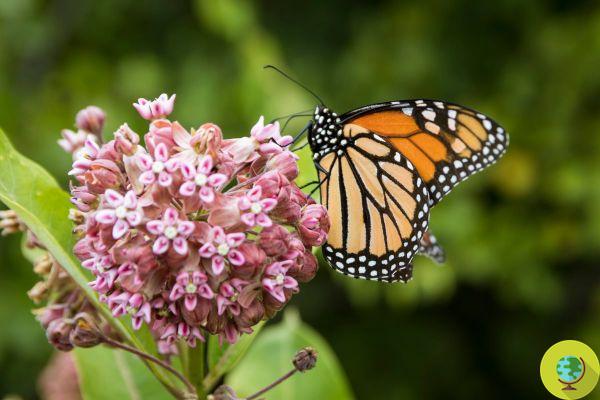
The stratagem put in place by butterflies to defend themselves from predators has turned into a simultaneous evolution of several species
He is about to end up run over, his mother saves himWhat seemed like a winning ploy implemented by these butterflies to defend themselves from predators actually turned into a simultaneous evolution that involved multiple species
The monarch butterfly (Danaus plexippus) has developed, through four genetic mutations, an ingenious stratagem to defend itself from its predators: it has learned to feed on a plant called milkweed, poisonous for animals (and also for humans) but not for her. The poison it feeds on pervades its entire body e effectively makes it untouchable for all its predators. What surprised the researchers of the University of California Riverside is the fact that this mutation was observed, the same, even in four very different predators but all united by the same "favorite dish": the monarch butterfly which, in the course of generations has ingested so much poison that it has become poisonous itself.
These four predators - a bird, a mouse, a wasp and a worm - carried out what the researchers called "simultaneous evolution" together with the butterfly they feed on, and it was their prey that stimulated this mutation to genetic level: the plant toxins present in his body have stimulated the organisms of predators to adapt to the poison, developing strategies to ingest it without dying or becoming intoxicated.
It is remarkable that evolution occurred at the molecular level in all of these animals - said the study co-author, Simon Green. - Plant toxins have caused evolutionary changes in at least three levels of the food chain. It appears, surprisingly, that they are developing resistance by using the same type of machinery at the same points in the genetic code of the monarch and the aphids, insects and beetles, which also feed on milkweed.
(Read also: The colorful monarch butterfly: travels 5 kilometers to return home)
For several decades, biologists have known that certain types of butterflies (including the monarch butterfly) and other insects have adapted to feed on milkweed and have developed toxin storage systems as a form of defense against predator attacks. But it is only in the last decade that geneticists have understood the actual genetic mutations within the sodium-potassium pump, which have allowed this adaptation to the venom. Now it has emerged that other animals, very different from each other, have been able to evolve in this way. But what are they?
Il black-headed grosbeak is a migratory bird that buys up monarch butterflies during their wintering in Mexico: after having captured its prey, it tears its wings and devours its entire abdomen, demonstrating that the presence of the poison does not cause any effect collateral - in fact, it is currently the only bird capable of eating the monarch butterfly without feeling sick, having developed three genetic mutations. The eastern deer mouse (close relative of the Mexican black-eared deer mouse) feeds on butterflies that fall to the ground and has mutations in genes that allow it to resist cardiac glycosides and other substances that would be toxic to other mammals. There scooter Trichogramma pretiosum, a parasite on monarch eggs, has developed two mutations in the sodium-potassium pump to resist the poison contained in the butterfly. Finally, the DNA of the nematode Steinernema carpocapsa, which parasites the larvae of insects that feed on milkweed, has demonstrated evolution through three genetic mutations.
Follow your Telegram | Instagram | Facebook | TikTok | Youtube
Fonte: Current Biology
We also recommend:
- Not all caterpillars become butterflies, some of them go to an end that has left even scientists stunned
- Biodiversity Day: each of us can save butterflies by contributing to their census
- Bees need generations to "heal" from the effects of exposure to insecticides


























